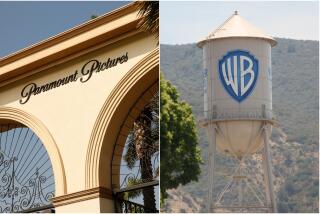Home Savings to Be Acquired in $10.1-Billion Deal
- Share via
Washington Mutual announced plans Tuesday to buy the owner of Home Savings of America for more than $10 billion, a stunning move that would result in the loss of up to 3,500 jobs and the closure of as many as 170 branch offices, most of them in the Southland.
Seattle-based Washington Mutual, already the biggest thrift in the nation because of a spree of recent acquisitions, said it would acquire Irwindale-based H.F. Ahmanson through an exchange of stock valued at $10.1 billion based on Tuesday’s closing market prices. The merger would create California’s second-largest financial institution and the nation’s seventh-largest.
The purchase of Home Savings, itself the nation’s biggest savings and loan for many years, would give Washington Mutual $150 billion in assets and 2,000 branches. It would enable Washington Mutual to supplant Wells Fargo & Co. as the main rival in the West to BankAmerica Corp.
“This is truly a unique and tremendous combination,” said Washington Mutual Chairman and Chief Executive Kerry Killinger, who will lead the combined companies. “We can go toe to toe with the major consumer banks in California.”
The combined entity would be the biggest mortgage lender on the West Coast and boost Washington Mutual’s market share in California (based on deposits) to 17%, just behind BankAmerica’s 20% share. The merged company would keep the Washington Mutual name.
Officials at both companies said it’s too early to tell how many branches and jobs will be lost in Orange County as a result of the buyout. Home Savings has about 600 employees in the county at 28 branches and a consumer-lending operation in Lake Forest.
Washington Mutual has about 40 branches still bearing the names of prior acquisitions, Great Western Bank and Irvine-based American Savings Bank. Those will be renamed to Washington Mutual next month.
A company spokesman said Washington Mutual plans to keep its giant administrative center--American’s old corporate headquarters in Irvine--after the acquisition of Ahmanson is completed.
The deal is one of the largest in a series of high-profile mergers in the financial services industry in recent years. Driven by the companies’ push to increase efficiency through size and by record high prices in the stock market, bank and S & L mergers are proceeding faster than at any point in history.
In the last decade, Washington Mutual has bought 21 companies. Home Savings itself acquired Coast Savings Financial in October.
*
But while the deals have captured headlines, they have often left customers angry and confused.
Some Home Savings customers, for instance, called Downey Savings & Loan offices Tuesday to see about switching their accounts, said the Newport Beach thrift’s chairman, Maurice L. McAlister.
“Here we go again,” said Peter Navarro, a professor in the Graduate School of Management at UC Irvine on Tuesday. “People in Los Angeles and elsewhere are not happy about musical banks. Bigger in banking does not mean anything better for the consumer.”
Alan Fisher, executive director of a nonprofit community investment group known as the California Reinvestment Committee, called the deal “a stunning next step in banking consolidation in this state.”
“There’s a concern about what this means in Los Angeles, where you have job losses and branch closures,” Fisher said. “There could also be fewer lending opportunities for consumers.”
But Wall Street cheered the deal.
Washington Mutual and Ahmanson are “an ideal fit” because of the possibility for massive cost-cutting through layoffs and branch closures, said Jonathan Gray, an analyst at the investment firm Sanford C. Bernstein & Co. in New York. Washington Mutual is expected to eventually slash its annual costs by $330 million.
More than 60% of Ahmanson’s bank branches are within a walk or short ride from a Great Western branch, Gray noted. Most of the closures are expected to occur in Southern California, where there is the greatest overlap of branches, analysts said.
Most of the projected 3,300 to 3,500 job cuts, some expected to occur through attrition, will occur here as well, they said. Washington Mutual said it would try to reassign some employees, and workers who are laid off would be given severance packages. The packages would vary depending on an employee’s position and experience, Killinger said.
Although the deal to buy Ahmanson comes before Washington Mutual has even completed absorbing Great Western, analysts predicted that Washington Mutual would not suffer the computer snafus and other well-publicized problems that Wells Fargo had after its 1996 acquisition of First Interstate Bank.
“They are expert consolidators,” said Donald Destino, analyst at the securities firm Jefferies & Co. in Los Angeles. “Generally, these have come off without a hitch.”
The deal brings together two companies that less than a year ago were bitter enemies battling to buy Great Western, then the nation’s third-largest thrift. Washington Mutual came in as a “white knight” and rescued Great Western from Ahmanson’s hostile offer with an $8-billion bid.
Takeover talks between Washington Mutual and Ahmanson got started March 4, when Ahmanson Chairman and Chief Executive Charles Rinehart, 51, called Killinger to propose the sale after the two men had socialized in January at a Federal Home Loan Bank board dinner in Seattle.
Rinehart, who would step aside to consider his options after the merger deal is finalized, said he made the call because he had decided Ahmanson was too small to thrive on its own--despite having $53 billion in assets.
“For quite some time now, we’ve believed scale would be increasingly important,” Rinehart said. “We concluded it would be in the interest of our shareholders and our employees if we could pick the time and the company” that would be the buyer.
Under terms of the deal, Washington Mutual will swap 1.12 shares of its stock for each Ahmanson share. Based on Tuesday’s closing market prices, the swap ratio represents a price of $81.69 for each Ahmanson share.
Ahmanson’s shares soared $12.38 a share Tuesday to close at $77.88 on the New York Stock Exchange. Washington Mutual’s stock gained $1.19 a share, to $72.94, on the Nasdaq market.
The merger is subject to approval by shareholders of both companies and regulators; the companies hope to close the deal in this year’s third quarter.
Recent signals that federal regulators are taking a closer look at mega-mergers might increase the chance for this deal to run into some antitrust obstacles, analysts said. But Killinger said he did not believe that there would be an antitrust problem.
Indeed, Killinger argued that banking consumers still have a plethora of choices in the financial services area, as many mutual funds and other companies now offer traditional banking services.
“Consumers aren’t just choosing among banks,” he said. “Day in and day out, our toughest competitors aren’t banks, they are mortgage companies.”
The increased competition among financial companies is one of the primary factors fueling the continued consolidation in the thrift industry, said Bert Ely, an independent banking analyst in Alexandria, Va.
Rivals such as General Electric Co.’s finance arm provide consumer credit and business loans. Countrywide Credit Industries Inc., based in Calabasas, is a giant provider of home mortgages. Charles Schwab Corp. is a huge reservoir of consumers’ savings and investment dollars. Washington Mutual (and Ahmanson) must compete with them and many others for business.
In fact, in 1980, banks and thrifts accounted for 42.5% of the total financial assets that were held by all U.S. financial institutions. But today, banks and thrifts have only 23.5% of the total, according to figures compiled by the Federal Reserve Board.
Even thrifts as big as Ahmanson realize that to stay competitive, grow their profits and adequately invest in new technology, they have to be in the same league as BankAmerica and Wells Fargo.
“The S&Ls; are sorting themselves out, so that there are a few big players and then lots of small players, like community banks, serving various niche markets,” Ely said. “And we haven’t seen the last of it.”
*
BankAmerica spokesman Cary Walker agreed, saying the proposed Washington Mutual-Ahmanson merger “points up the fact that financial institutions are scrambling to gain a bigger foothold in California.” Walker said the merged company “would certainly be a formidable competitor.”
Despite concerns that the acquisition and resulting job losses may hamper the local economy, Jack Kyser, chief economist for the Los Angeles County Economic Development Corp., said “it really doesn’t mean anything for our Los Angeles economy.”
Kyser said other financial institutions, such Mellon Bank and Citicorp, have recently increased operations in Los Angeles, with Citicorp recently putting its name on a downtown office tower.
And the deal is expected to make remaining California banks, like Wells Fargo and Golden State Bancorp, even more attractive takeover targets to out-of-state giants such as NationsBank Corp. of Charlotte, N.C.
*
Times Staff Writers Russ Stanton and James S. Granelli contributed to this report.
More to Read
Inside the business of entertainment
The Wide Shot brings you news, analysis and insights on everything from streaming wars to production — and what it all means for the future.
You may occasionally receive promotional content from the Los Angeles Times.











